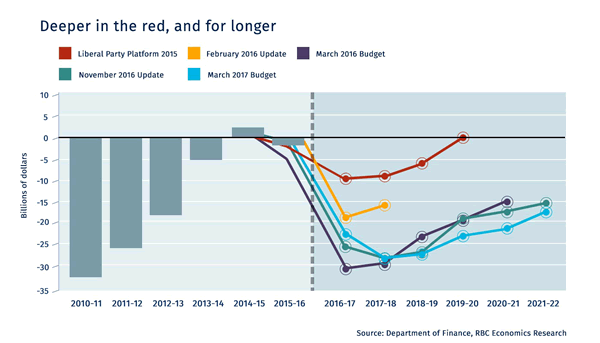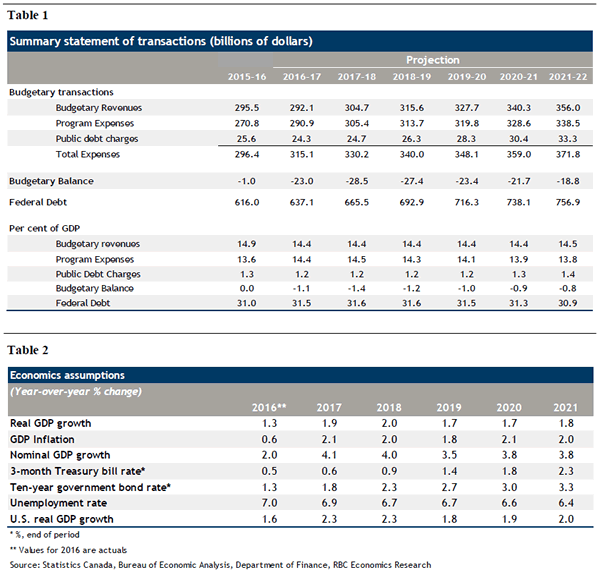Overview
Today’s Heading into Budget 2017 expectations were for a stay-the-course budget with little in the way of new initiatives. In the event, this is largely what the government delivered with a few more details announced around their spending plans and a couple of modest initiatives aimed at spurring innovation in the economy. This ‘restraint’ largely reflects their stretched fiscal position. Following substantial spending initiatives announced in last year’s budget and the ensuing fall statement, the fiscal path is now one of deficits as far as the eye can see. Earlier talk of balancing the budget has been long forgotten and had been replaced by a goal of reducing the debt-to-GDP ratio which is a much less stringent goal. Unfortunately this trend of a weakening fiscal resolve continued as today’s budget dropped the debt-to-GDP target altogether. Over the next 6 years the debt-to-GDP ratio is expected to move sideways, ending at 30.9% of GDP and an additional $141 billion in federal debt.
This unchecked spending had prompted concerns within the federal government of revenue shortfalls seemingly missing the point that it is of their own doing. Thankfully no major tax increases were announced in today’s budget. However, this good fortune could be temporary as any disappointing surprises in the economic outlook could derail the government’s fiscal plan necessitating higher taxes to fill a deepening fiscal hole.

Fiscal Balance Projections
The deficit profile indicated in Budget 2017 is little changed from what was indicated in the 2016 fall statement. The deficit is marginally lower in fiscal 2016/17 at $23.0B relative to $25.1B indicated last fall. The smaller deficit reflects both lower program spending and public debt charges and higher revenues. Beyond fiscal 2016/2017, the deficits are generally higher. The fiscal 2017/18 deficit rises to $28.5B and compares to $27.8B in the fall statement. The deficit then steadily trends lower through the medium term dropping to $18.8B by fiscal 2021/22. However, the profile is consistently above the profile indicated in the fall. Cumulatively the deficit is higher by $13.3B over the next six fiscal years. This higher profile could be attributed to the reintroduction of a $3.0B ‘adjustment for risk’ over the five fiscal years from 2017/18 to 2021/22. The budget did indicate increased infrastructure spending though this has largely been financed by reallocating funds that had previously been allocated for infrastructure in Budget 2016 but not spent. The federal government is still of the view that this spending will contribute to a sizeable 0.4 percentage point lift to Canadian growth in fiscal 2016/17. Budget 2016 had talked about a ½ per-centage point lift over each of the next two fiscal years. Budget 2017 did not opt for any major tax changes. There was no change to the capital gains tax that had been widely speculated upon as a tax rate that could be raised. The prospect of potential tax cuts in the U.S. possi-bly stayed the federal government’s hand as it opted not to unduly hamper the ability of the Canadian economy to attract and retain workers.
Initiatives
Increased infrastructure spending was most evident in spending for community building which saw spending boosted $20.6B over the next six years. This included various housing initiatives that will see increased spending of $5.3B. The lion’s share of this spend-ing is for expanding and/or improving the housing stock. (This total also included a welcome, albeit small $40 million over five years, increase in funding to Statistics Canada to establish a Housing Statistics Framework that will better identify factors driving housing market dynamics and thus facilitate designing the appropriate policy response.) Another major initiative was increased spending of $8.3B over the medium term for enhancing skills development of Canadian workers. The other major area of increased spending of $8.2B was largely focussed on improving health care for Canadians. Within these spending areas the federal government stressed it was trying to address various gender imbalances by allocating, over the next 11 years, $7B towards "early learning and child care and over $11.2B towards a National Housing Strategy."
Fiscal Savings
A lion’s share of these new initiatives were largely financed by reallocating funds that had been previously been budgeted but not spent. Over the next six years this represented a freeing up of a cumulative $27.1B. Another $4.7B in savings was projected to be sourced by increasing tax fairness via measures such as closing tax loopholes and better policing of tax evasion (although the public transit tax credit will also be eliminated). Budget 2017 did not propose any major tax changes.
Fiscal Overview
The downward trend in the deficit from the projected peak in fiscal 2017/18 of $28.5B to $18.8b in fiscal 2021/22 is the result of revenues rising 4.0% per-year while program expenses increase by a lesser 2.6%. To some extent spending over these four years is restrained by front end loading a sizeable 7.4% surge in 2016/17 program spending. The rise in revenues over the forecast period is facilitated by nominal GDP growth projected to almost double over the period 2017 through 2021 to 4.3% from the 2.3% achieved in 2016. The rise in this growth rate in large part reflects the recovery oil prices over the forecast. RBC’s near-term nominal GDP growth outlook assumes an even stronger 4.8% over the next two years. Stronger nominal GDP growth would imply an even faster pace of revenue growth. This issue left unanswered in Budget 2017 is whether any fiscal savings will be used to pay down the debt more quickly as opposed to providing scope to raise expenditures further.
Financing Requirements
Financial requirements are set to rise to C$38.7bn in FY17/18 from a downwardly revised C$21.0bn in FY16/17, with the latter largely due to a smaller deficit than in the FES and a higher gain in the non-budgetary category "Pensions and other accounts" than previously projected. In terms of GoC bond issuance, we should see a record C$142bn in issuance (~C$7bn more than in FY16/17), though with very few changes to the program and continued emphasis on short- and medium-term bond (83% in maturities 5-years and under). Looking ahead, the Government is projecting C$167.4bn in financial requirements from FY17/18 through FY21/22. This, along with rising bond maturities, will prompt a decision from the DoF/BoC on whether to further increase short-term bond issuance or term out somewhat (or a combination of the two).













